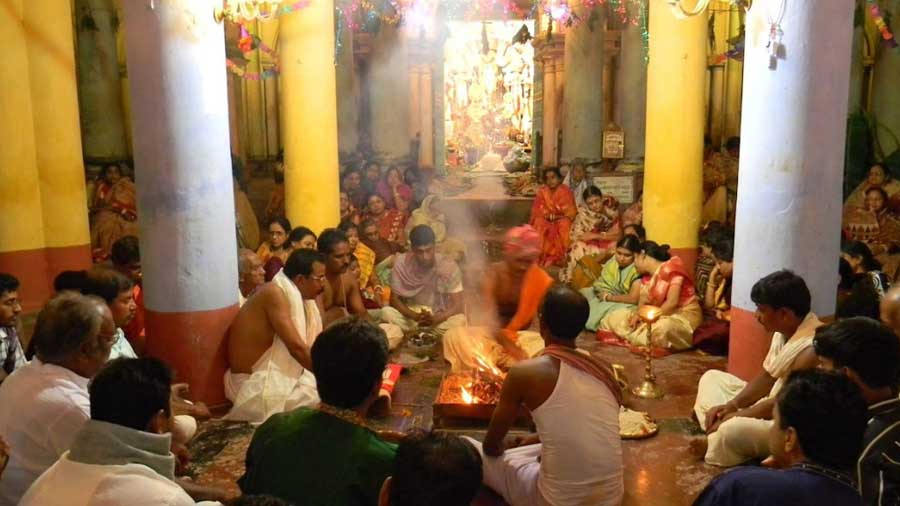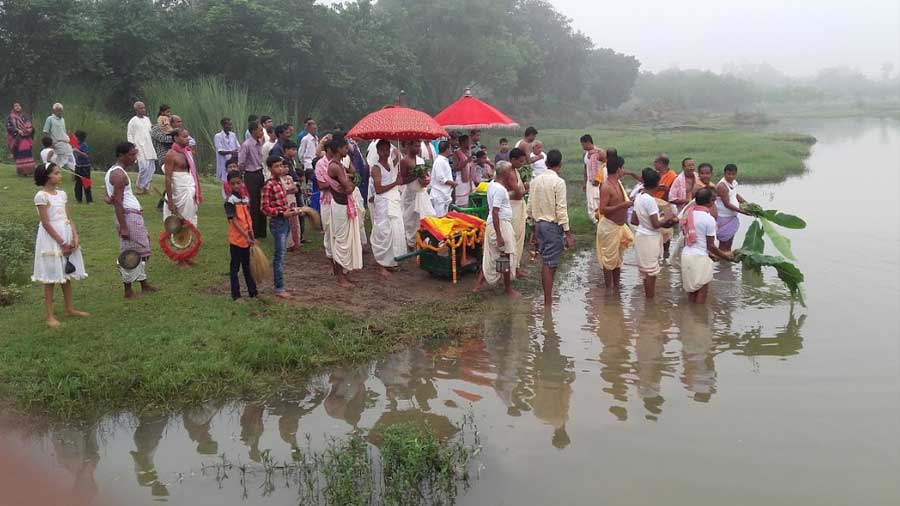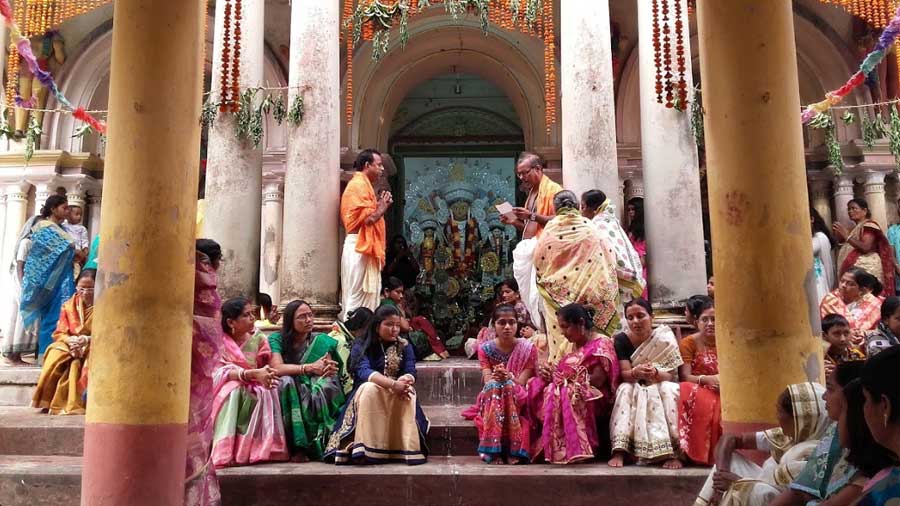Can you imagine Durga Puja celebrations without the beat of the dhak? Well, there is at least one traditional household in West Bengal, at Bankura district, where the celebrations take place without the sound of dhaks. This tradition belongs to the Mondal family of the twin villages of Hadal-Narayanpur, on the banks of the river Bodai in the Bishnupur subdivision of Bankura district. They also have many other interesting and unique rituals.
The history of the family began when descendants of a Sadgop caste man named Kalipada Ghosh arrived at Hadal from his ancestral land in Burdwan. After staying at Hadal for some generations, a descendant named Muchiram Ghosh developed a close friendship with Shubhankar Das — the famous mathematician who was employed as Tarafdar of Parulia under the ruler of the area, Malla Rajah Gopal Singh Dev.

A Hom ceremony at Boro Taraf Souvik Mondal
Subhankar introduced him to the king, who at a later stage bestowed the title ‘Mandalpati’ in a ‘Sanad’ (certificate) to the family. Since then, their surname changed from Ghosh to Mandal. One of the new-borns was named Sanando on the occasion of receiving the Sanad. The present residents of the Mondal family at Hadal-Narayanpur are descendants of Sanando Mondal.
In subsequesnt years, the family got divided into three — Boro Taraf, Mejo Taraf and Choto Taraf.
Becharam Mondal of Boro Taraf built a huge mansion with Durga dalan and nat mandir. Inside the premises, there is a Radha Damodar temple housing a family deity made of Shalgram stone. A ‘Rasmandap’ with a nat mandir is located just outside the house. The Mejo Taraf showcases a Nabaratna temple with exquisite terracotta work, built during the time of Nrisingha Murari Mondal.

An idol of the Mejo Taraf Arkadeep Mondal
Finally, the Choto Taraf has another Nabaratna temple built by Baburam Mondal, as well as its own nat mandir and Durga dalan. All the temples have exquisite panels of Goddess Durga in the ‘Singhabahini’ pose. It is interesting to note that though Durga Puja is celebrated with pomp and splendour, the Mondal family performs Vaishnava rituals
The Durga Puja of Boro Taraf at Narayanpur is the oldest of the three and is being held for about 250 years. For the last five generations, the idol is made at the thakur dalan of Boro Taraf by an artisan’s family. The clay for building the idol and holy Ganges water is brought from Katwa — a scared place for Vaishnavites. The task of idol creation starts from the day of Janmastami and ends before Sashthi. Just after Mahalaya, from Dwitia, musicians start playing musical instruments at the nat mandir. During Durga Puja, the absence of sound of the dhak is compensated by a combination of musical instruments like dhol, jagajhampa alias charkoti (a type of kettle drum) and percussions used by band parties.
The face of the deity of Boro Taraf has a resemblance to Bishnupur’s Mrinmoyee idol of Durga. The major difference is that the Bishnupur idol has her face tilted to her right side, while the one at Hadal-Narayanpur looks on straight. Also, the Bishnupur’s deity is a single figurine, while that of Hadal-Narayanpur is with her family. The face of Durga is significantly bigger than her children. The Goddess is decorated with white shola (cork) jewelleries. She is adorned with a gold crown and other golden ornaments before ‘Bodhon’. Every year, many devotees offer gold ornaments to the deity, which are kept at the ‘Debottar Estate’.

An idol of the Choto Taraf Himanka Shekhar Mondal
Initially at Mejo Taraf, a painted or ‘Poter Durga’ used to be worshipped, but was later changed to a clay deity. The rituals are more or less like Boro Taraf’s, although they do not have a permanent Durga dalan. Choto Taraf has a small but permanent Durga dalan. The idols of Mejo Taraf and Choto Taraf look similar to each other, but is completely different from that of Boro Taraf. Their deities are not decorated with shola and their chalchitras are designed in a somewhat different style.
The Durga dalan of Boro Taraf is decorated with a Belgian-glass-made chandelier. Other than gold, devotees offer the Goddess a massive sized sweet called ‘kadma’, which is made in and delivered from Mankar in Purba Bardhaman district.

An age-old handwritten notebook details the items and procedures for the puja Amitabha Gupta
The puja is conducted as per the rules laid out in Gupta Press Panjika (almanac). The Mondals have an age-old handwritten notebook, where a list of items and procedures for the puja is mentioned. On Saptami, Nabapatrika rituals take place in a grand procession with many people involved.

Nabapatrika rituals take place in a grand procession Souvik Mondal
The puja at Mondal household follows the Vaishnava style. The menu offered to the Goddess is purely vegetarian. Cooked rice (anno bhog) is not offered. Instead, fruits, sweets and luchis are offered. During the puja days, the family members and guests are treated to a variety of vegetarian food. There is even a printed, predefined menu.
There is no animal sacrifice, but vegetables like white gourd and sugarcane are ‘sacrificed’. Thirteen kinds of sweets are also offered. On Dashami, a Ceylon snakehead fish (locally known as chyang) is sacrificed, only after which the family members have non-vegetarian food.
Incidentally, there is no female involvement in the ‘Boron’ rituals of Hadal-Narayanpur. Here, the men of the house are involved in the traditional circular movement around the Goddess. Then, the deity is finally immersed in the local Bodai river. After immersion, the ‘Kathamo’ is retrieved from the river and vermillion is painted on it. After this ritual, the womenfolk of the Mondal household indulge in ‘Sindoor Khela’. Next year, the Goddess is recreated on the same ‘Kathamo’ in the same style.
Amitabha Gupta is a travel writer and a photographer who specialises in heritage and history of West Bengal. His work has been featured in many magazines and newspapers — both online and offline. He also conducts heritage walks and tours in and around Kolkata.
